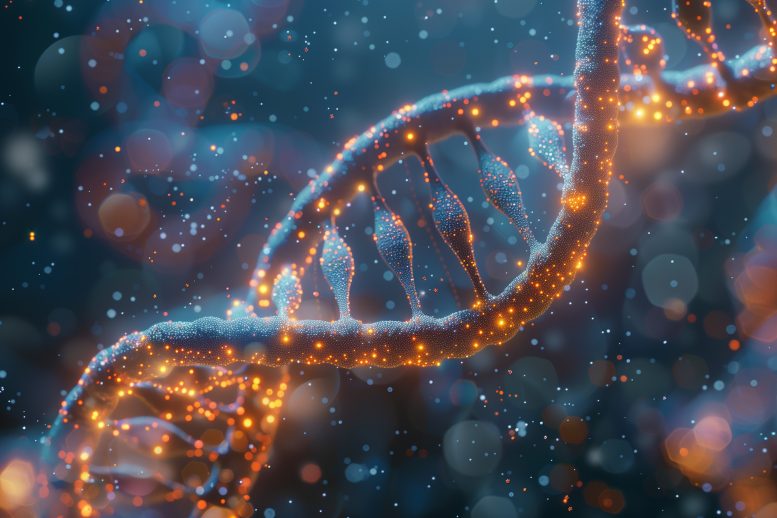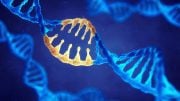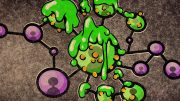
UC San Diego researchers developed new genome editing tools, multiplexed orthogonal base editors (MOBEs), which efficiently install multiple point mutations at once. This tool enhances the understanding and modeling of genetic diseases by allowing for controlled variant installation in the lab, offering a new approach to studying complex diseases. Credit: SciTechDaily
MOBEs, new genome editing tools from UC San Diego, allow precise, simultaneous genetic modifications, enhancing disease modeling and therapeutic development.
The human genome consists of approximately 3 billion base pairs, and humans are 99.6% identical in their genetic makeup. The remaining 0.4% accounts for differences between individuals. Specific combinations of mutations in these base pairs provide essential clues about the causes of complex health issues, including heart disease and neurodegenerative diseases like schizophrenia.
Traditional methods for modeling or correcting mutations in live cells are notably inefficient, particularly when installing multiple point mutations simultaneously across the genome. However, researchers from the University of California, San Diego have developed new genome editing tools called multiplexed orthogonal base editors (MOBEs) that can efficiently install multiple point mutations at once. The research, led by Assistant Professor of Chemistry and Biochemistry Alexis Komor, has been published in Nature Biotechnology.
The Role of Single Nucleotide Variants
The researchers focused on comparing genomes that differ at a single letter change in the DNA. Those letters — C (cytosine), T (thymine), G (guanine), A (adenosine) – are known as bases. Where one person has a C base, another person might have a T base. These are single nucleotide variants (SNVs) or single point mutations, a person might have 4-5 million variants. While some variants are harmless, others are harmful, and often it is a combination that confers disease.

The newly developed multiplexed orthogonal base editors (MOBEs) minimize unwanted edits while still achieving high levels of efficiency. Credit: Alexis Komor lab / UC San Diego
Challenges in Genetic Disease Modeling
One issue with using the genome in disease modeling is the sheer number of possible variations. If scientists were trying to determine which genetic mutations were responsible for heart disease, they could decode the genomes of a cohort that all had heart disease but the number of variations between any two people makes it very hard to determine which combination of variations causes the disease.
“There is a problem interpreting genetic variants. In fact, most variants that are identified are unclassified clinically, so we don’t even know if they’re pathogenic or benign,” stated Quinn T. Cowan, a recent Ph.D. graduate from the university’s Department of Chemistry and Biochemistry and first author on the paper. “Our goal was to make a tool that can be used in disease modeling by installing multiple variants in a controlled laboratory setting where they can be studied further.”
Evolution of Gene-Editing Tools
To understand why MOBEs were created, we have to understand the limitations of the traditional gene-editing tool CRISPR-Cas9. CRISPR-Cas9 uses a guide RNA, which acts like a GPS signal that goes straight to the genomic location you want to edit. Cas9 is the DNA-binding enzyme that cuts both strands of the DNA, making a complete break.
Although relatively straightforward, double-stranded breaks can be toxic to cells. This kind of gene editing can also lead to indels — random insertions and deletions — where the cell is not able to perfectly repair itself. Editing multiple genes in CRISPR-Cas9 multiplies the risks.
Instead of CRISPR, Komor’s lab uses a base-editing technique she developed, which makes a chemical change to the DNA, although only one type of edit (C to T or A to G, for example) can be made at a time. So rather than scissors that cut out an entire section at once, base-editing erases and replaces one letter at a time. It is slower, but more efficient and less harmful to cells.
Introduction of MOBEs
Simultaneously applying two or more base editors (changing a C to T at one location, and an A to G at another location in the genome), allows for better modeling of polygenic diseases — those occurring due to more than one genetic variant. However, previously no technology could efficiently apply multiple edits without guide RNA “crosstalk” — unintended edits.
Cowan’s MOBEs use RNA structures called aptamers — small RNA loops that bind to specific proteins — to recruit base-modifying enzymes to specific genomic locations enabling simultaneous editing of multiple sites with high efficiency and a lower incidence of crosstalk.
Proof of Principle and Future Applications
This system is novel and is the first time someone used aptamers to recruit ABEs (adenosine base editors) in combination with CBEs (cytosine base editors) in an orthogonal pattern to make the MOBEs.
The differences are stark: when CBE and ABE are given together not using MOBE, crosstalk occurs up to 30% of the time. With MOBE, crosstalk is less than 5%, while achieving 30% conversion efficiency of the desired base changes.
The study was a proof of principle to test the feasibility of the MOBE system, which has been granted a provisional patent. To test them even further, the team conducted several case studies with real diseases, including Kallmann syndrome, a rare hormonal disorder. Their experiments revealed that MOBE systems could be used to efficiently edit relevant cell lines of certain polygenic diseases.
“We’re in the process of putting the plasmids up on AddGene so anyone can freely access them. Our hope is that other researchers will use the MOBEs to model genetic diseases, learn how they manifest, and then hopefully create effective therapies,” stated Cowan.
Reference: “Development of multiplexed orthogonal base editor (MOBE) systems” by Quinn T. Cowan, Sifeng Gu, Wanjun Gu, Brodie L. Ranzau, Tatum S. Simonson and Alexis C. Komor, 21 May 2024, Nature Biotechnology.
DOI: 10.1038/s41587-024-02240-0
This research was funded in part by the National Institutes of Health (1R35GM138317, T32 GM008326, and T32 GM112584) and the Research Corporation for Science Advancement (28385).
Full list of authors: Quinn T. Cowan, Sifeng Gu, Wanjun Gu, Brodie L. Ranzau, Tatum S. Simonson, and Alexis C. Komor (all UC San Diego).









Be the first to comment on "Decoding Disease: UC San Diego’s Leap in Gene Editing"